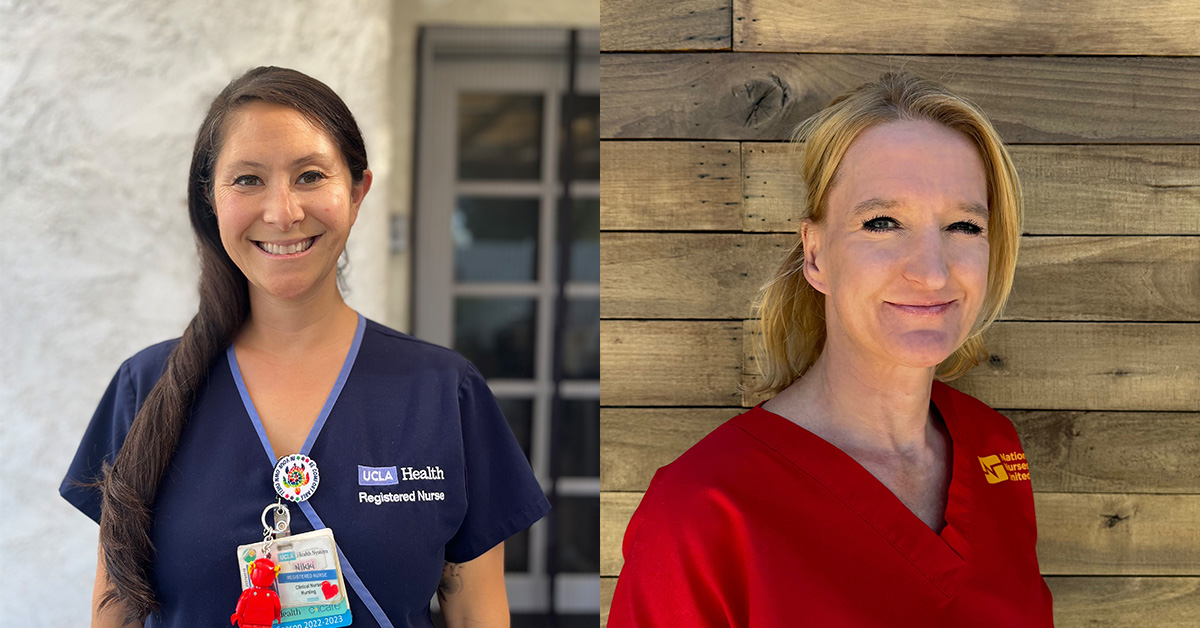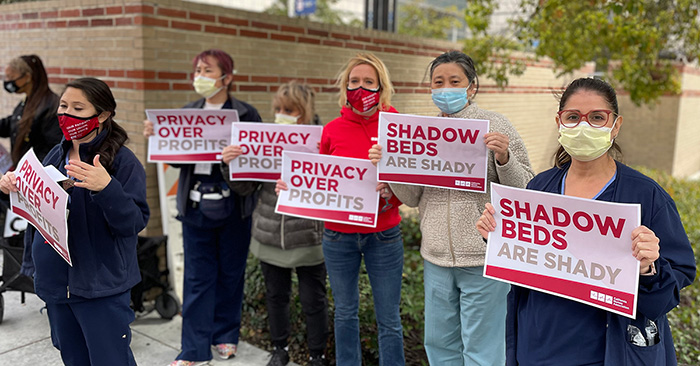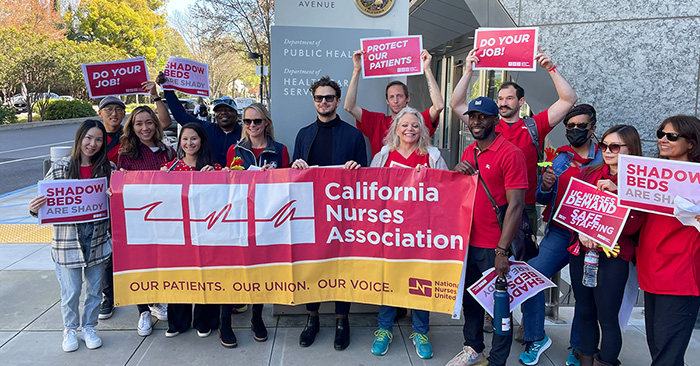Winning Big

How UCLA’s PPC stopped the practice of doubling patients in single-occupancy rooms
By Chuleenan Svetvilas
National Nurse magazine - July | August | September 2024 Issue
When the “tripledemic” of Covid, influenza, and respiratory syncytial virus (RSV) hit in the winter of 2022, the pediatric unit at Ronald Reagan UCLA Medical Center in Los Angeles was at maximum capacity. Management’s solution was to get a waiver to add “shadow beds,” their term for the placing of an additional unlicensed bed in a single occupancy room. “It was a nightmare from day one,” recalled Nikki Cuadra, RN in UCLA’s pediatric unit. “We found out about it during a huddle but there was no plan or system in place for shadow beds.”
“There wasn’t enough space in the room for the extra IV cords, drips, and extension cords,” said Cuadra, who is also a member of UCLA’s Professional Practice Committee (PPC). “It was unsafe to walk through to get to each patient.”
Even worse, if you needed emergency oxygen or suction for the patient in the shadow bed, it did not always work. “Primary oxygen was set up for one bed,” noted Cuadra. “The other side had a splitter device installed. It wasn’t something we could count on working when we needed it.
UCLA’s use of shadow beds began in March 2020 after California Gov. Gavin Newsom declared a state of emergency due to the Covid-19 pandemic, which allowed hospitals to request waivers from the California Department of Public Health (CDPH) to add unlicensed beds. UCLA nurses waged a three-year campaign to stop management’s use of space waivers that let them place two patients in single occupancy rooms and in hallway beds in the emergency department.
Squeezing in a shadow bed, plus all the associated equipment and extra wiring as well as makeshift dividers, was not safe for patients or nurses. Not only was the room filled with potential trip hazards, but there was also little to no space for a crash cart if a patient needed emergency intervention, not to mention the lack of privacy or dignity for patients. Hallway beds in the emergency department were arguably worse, with no privacy, no call lights, no infection control, and a dearth of proper equipment.
The PPC has the authority to document unsafe practices and the power to make real changes because it is part of collective bargaining agreements negotiated by California Nurses Association/National Nurses Organizing Committee (CNA/NNOC). The PPC, composed of elected staff RNs who represent every major nursing unit, meets with hospital administration about working conditions and any changes that affect patient care, nursing practice, and workplace safety. CNA represents nearly 22,000 nurses across the University of California (UC) system, including nearly 5,400 RNs at UCLA.
Campaigns to change the situation — whether it’s improving patient care or enforcing certain contract terms — typically start with the PPC and can last anywhere from a few months to a few years. Sometimes the bigger the fight, the bigger the win.
Nurses on the PPC know that speaking up and holding management accountable is what makes change possible. “The PPC makes sure management in the hospital is following policies and practices promised to us,” said Cuadra. “We also help and support nurses if they face any injustices when they stand up for patients.”
When Covid numbers were down in 2021 and there was no clear need to continue the shadow beds or hallway beds, nurses began filing assignments despite objection forms (ADOs) documenting their concerns. UCLA had acquired Olympic Medical Center in January 2021 and closed it, which infuriated nurses because UCLA patients were being doubled up in single rooms and spending days in the hallway. PPC members and RN leaders began handing out flyers to patients, urging them to call UCLA Health’s Office of the Patient Experience about the shadow beds and hallway beds. Meanwhile, CDPH extended the expiration date of space waivers to the end of 2021.

The RNs’ fight continued in 2022 when CDPH extended space waivers through June and UCLA did not stop using shadow beds or hallway beds. Kathrin Muellerchen, RN at UCLA and chair of the PPC, says that at every PPC meeting with management, nurses demanded that UCLA stop the use of shadow beds and hallway beds because it was unsafe for patients and nurses. The union also sent detailed requests for information (RFIs) from 2022 to 2023 about the waivers, including what were the policies and procedures to request waivers and what training was available to nurses and other health care workers to ensure safe care in rooms with shadow beds.
In fall of 2022, Gov. Newsom announced that California’s state of emergency would end in February 2023, which meant all waivers would expire. But nurses knew that UCLA was not making any plans to stop using shadow beds or hallway beds. Fed up, their campaign began to escalate. “We held virtual town halls with members and showed them how to file complaints with CDPH,” said Muellerchen, RN in a medical-surgical unit. “Management was so pushy about putting patients in shared rooms. ”
UCLA nurses continued to file complaints with CDPH but when the department conducted its investigations, it found a majority of RNs’ complaints “unsubstantiated” in 2022 and 2023 — most likely due to investigators meeting with managers, not the nurses who filed the complaints. Most of the time nurses did not know when or if any investigations were conducted.
When the state of emergency officially ended on the last day of February, the PPC was fully prepared for management’s inaction. The next day, March 1, the RNs held a rally outside the hospital demonstrating the reality of cramming two beds in a single room by putting beds side-by-side at the event. They also delivered a petition to the CNO, signed by about 1,200 nurses, demanding that UCLA stop applying for additional space waivers or extensions to waivers and listed more than a dozen issues.
Much to nurses’ dismay, CDPH created a “flexibility request” that allowed facilities to continue using unlicensed beds. UCLA applied for space waivers under this new process but neglected to tell nurses. They found out about it from news reporters.
CNA contacted CDPH about the flexibility waivers and began surveying UCLA nurses about the impact of shadow beds and hallway beds on patient safety, delivering the survey results in June to the CNO and to CDPH offices in El Monte, which oversees UCLA facilities. “The survey included examples of our concerns,” said Muellerchen. “There were infection risks. Immunocompromised patients were put in shared rooms, which was not safe for them. Patients who objected to being in a room with a shadow bed were offered medication to cope with the stress instead of being given a single room.”
The PPC continued to put the shadow bed and hallway beds concerns on the agenda for each quarterly meeting with the CNO and finally had a breakthrough in August 2023 when CNA was notified that shadow beds would be decommissioned until there were just two shadow beds per inpatient unit. However, more than 40 hallway beds were still in use in the ED.
In February 2024, when Cuadra learned that CDPH was conducting a site visit in her unit, accompanied by managers, she introduced herself to the state officer and said, “Hi, I’m one of the people who filed a complaint.” She took them to a room with a shadow bed and when she opened the door, it hit the recliner chair of a patient’s parent. When the CDPH officer saw the crowded room, they were appalled and agreed that it was unsafe and completely unacceptable. Not long after that, Cuadra says there was a “loose rule to limit the number of shadow beds.”

In March, UC nurses from across the state held a rally in front of CDPH offices in Sacramento, the state capital, to bring attention to their ongoing patient safety issues and CDPH’s failure to respond appropriately to their concerns with thorough and transparent investigations and reporting. As a result of that action, UCLA nurses won a huge victory: As of April, an existing UCLA policy is now being enforced more frequently, which states that shadow beds are not allowed unless there are no other available beds. “Bed control must go up the chain of command and can only use a shadow bed if there’s a surge,” said Cuadra.
Chuleenan Svetvilas is a communications specialist at National Nurses United.